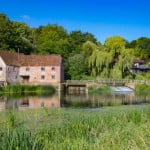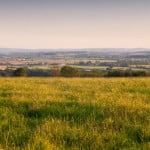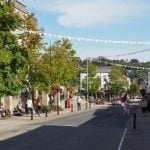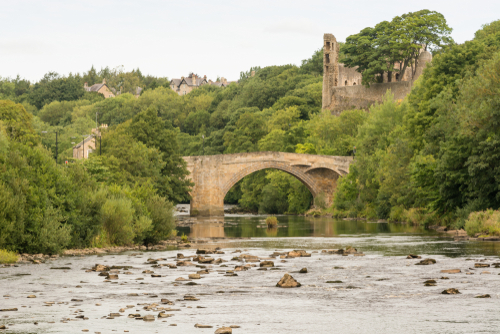
Barnard Castle is a market town and the main settlement in the Teesdale area of County Durham in the North East of England. The town stands on the north bank of the River Tees, about 21 miles (34 km) southwest of the county town of Durham and 16 miles (26 km) west of Darlington. The town is dominated by the late 11th-century castle from which it takes its name and with whom its history is indelibly linked. The town is often referred to as ”Barney” by its residents and those across the wider region. At the 2011 national census, Barnard Castle had a population of 11,829.
A Fleeting History
The Romans arrived in the Teesdale area in the 1st century and built several forts close to Barnard Castle. Archaeological evidence has uncovered that there was a Roman road that ran between Bowes (Lavatrae) and Binchester (Vinovium). It’s also known there was a ford crossing of the River Tees on the road at Barnard Castle, suggesting the site was of some considerable importance during the Roman Era. However, the real story of Barnard Castle doesn’t begin until after the Norman Conquest.
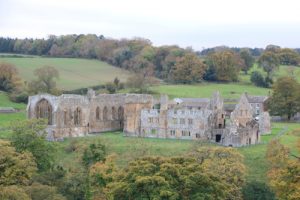
The impressive ruin of Egglestone Abbey
In 1093, Guy de Baliol was granted the lands in and around Barnard Castle by William Rufus, son of William the Conqueror. It’s thought that he built a wooden fort at the current site of the town’s castle. Guy’s son and successor, Bernard de Baliol, replaced the timber structure with a stone castle that took twenty years between 1112 and 1132 to build. He also founded St Mary’s church around the same time which was built less than half a mile from the castle. The establishment of the church and castle was soon to encourage the growth of a settlement in the area. In the second half of the century, Egglestone Abbey was also built, sited about a mile southeast of the castle. Over time both the stronghold and the surrounding settlement began to be referred to as ”Bernard’s Castle”, which eventually became corrupted to ”Barnard Castle”.
Throughout the 13th century, the castle remained in the hands of the Balliol family. In 1292, with the help of Edward I, John de Balliol ascended the Scottish throne. However, he proved to be an incompetent monarch and fell from power only 4 years later. At that time, Antony Bek, Bishop of Durham, decided to take advantage of the situation and seized Barnard Castle for the church. However, in 1306, Edward I repossessed the castle for the crown. The following year, the dying king bequeathed the castle to Guy de Beauchamp, the 10th Earl of Warwick. His descendants were to hold on to the castle for the next 164 years.
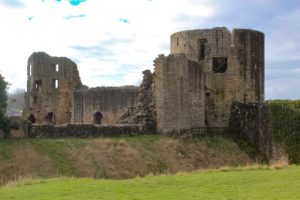
Part of the ruin of the 12th century Barnard Castle
In 1446, the Beauchamp’s were without a male heir, so the earldom and estates passed to Richard Neville, husband of Anne Beauchamp. In 1472, Richard, Duke of Gloucester and future Richard III, inherited Barnard Castle when he married Anne Neville. When Richard died at the Battle of Bosworth Field in 1485, the new Tudor king, Henry VII, became the new owner of Barnard Castle. Henry placed the care of the castle into the hands of keepers, the locally influential Bowes family.
In 1536, Sir Robert Bowes surrendered the castle without confrontation with the rebel forces involved in an uprising (Pilgrimage of the Grace) against Henry VIII’s dissolution of the monasteries. However, Bowes appears to have very much boxed clever. He first sided with the insurgents and went on to become one of their leaders, carrying their petition to the king. However, when the cause looked lost, he reverted firmly back to the king’s service and helped to restore the rule of the crown.
The Rising In the North
In 1569, during the reign of Queen Elizabeth I, the people of Barnard Castle were involved in the Rising of the North, a rebellion against the rule of the protestant monarchy. The aim of the revolt, led by Charles Neville, 6th Earl of Westmorland, and Thomas Percy, 7th Earl of Northumberland, was to bring Mary Queen of Scots to power. As the rising progressed, Sir George Bowes, the crown’s keeper of Barnard Castle, put the stronghold in lockdown. Rather than face the rebels head-on Sir George reasoned that he should hold the castle for Elizabeth. However, the 700 men or so men who were also locked in the castle with Sir George did not all share his sentiments and there was a steady stream of desertions. After 11 days, Bowes was forced to surrender but he had bought enough time for the rebellion to be crushed shortly afterward. Luckily for Sir George, he came out of the incident quite well with his reputation more or less intact.
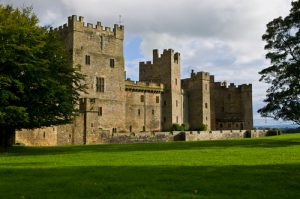
Raby Castle was built around 1390
While Neville and Percy managed to flee to Scotland they were eventually captured. And in 1572, were executed at York. Royal displeasure at the local support shown for the Rising reputedly saw a curfew placed on Barnard Castle. This meant all townsfolk had to be home by 8 pm. The beginning of the curfew was signalled each evening by the ringing of church bells. An alternative theory is that the bells had actually been rang in the town since Norman times when it served as a reminder for people to dampen down their fires at the end of the day – an important consideration when houses were made of timber. Either way, the custom of the 8 pm bell-ringing continued down the centuries and was practiced until around the end of World War II.
In 1626, the Crown sold both Barnard Castle and Raby Castle to politician Sir Henry Vane, who decided to make Raby Castle his principal residence. Consequently, Barnard Castle was abandoned and its contents and much of its masonry was robbed for the maintenance and betterment of Raby Castle.
18th Century Barnard Castle
By the beginning of the 18th century, while milling for the production of timber, corn and paper were present, the woollen industry had emerged as Barnard Castle’s main source of employment. Local wool was gathered from farms, and domestic weaving and spinning became popular, especially in the Bridgegate and Thorngate areas. However, by the beginning of the 19th century, the demand for wool cloth had seen a rapid decline. Thus, a new initiative for the use of wool in the town was urgently needed.
Luckily, Britain was now seeing a rise in the demand for carpets, so entrepreneurs in Barnard Castle were quick to seize the opportunity. New factories were built along the River Tees, steering the manufacture of woollens away from the cottage industry it had previously been. The production of carpets in the town quickly overtook that of other woollen produce. By 1834, Barnard Castle was home to at least seven sizable carpet manufacturers. However, in less than 30 years the town’s carpet-making industry went into serious decline. By 1863, Monkhouse, the town’s largest carpet manufacturer had closed their gates.
By the 1830s, there were at least 30 public houses and inns in Barnard Castle. They were popular with both locals and an ever-increasing number of travellers. They also served as convenient hubs for ‘carriers’. These were men employed to transport goods between the small peripheral towns, such as Barnard Castle, and the much larger population centres of Newcastle, York, Leeds, and the like. However, carriers were effectively to become redundant with the development of the railways. In 1856, Barnard Castle was made a stop on the South Durham & Lancashire Union Railway between Bishop Auckland and Kirkby Stephen East. In August 1861, a new westbound rail line was opened from a second terminus to a junction with the Lancashire & Carlisle Railway, facilitating connectivity across the Dales. However, in May 1862, the original station was closed to the travelling public, meaning all passenger services then operated from the town’s second station.
Barnard Castle In WWI
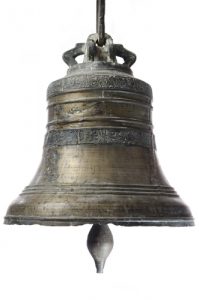
Ringing of the town’s church bells at 6 am was practiced until 1927
In World War I, 125 servicemen from Barnard Castle were killed in the conflict. Five of the casualties were brothers, the sons of the town’s Margaret and John Smith. The last brother died in July 2018, prompting the local vicar’s wife to write to Queen Mary, wife of King George V. She pleaded for the Queen to intervene to make sure that the Smith’s youngest son, Wilfred, was spared the fate of his brothers. The Army actioned the request on compassionate grounds and Wilfred went on to return to Barnard Castle after the war.
Up until 1927, Barnard Castle’s residents were used to receiving a 6 am daily wake-up call by the ringing of the church bells, a custom that had been implemented in the 18th century to wake the town’s mill workers. While it had been a fairly common practice at mill towns across the country, Barnard Castle was one of the last places in the county to continue with the daily event. Making way for progress, by 1927, it would seem that most people had managed to acquire an alarm clock.
In 1941, during World War II, Stainton Army Camp was built about 2 miles northeast of Barnard Castle. Part of the camp went on to be utilised as a POW centre. After the war, the camp was utilised as a holding facility for units about to be deployed on active operations. In 1972, most of the camp was closed but a small part remained open as a cadet training centre which still survives today.
In November 1964, Barnard Castle train station was closed to passengers, while freight traffic ceased in 1965.
The Modern Era
GlaxoSmithKline (GSK) is by far Barnard Castle’s largest employer, with the town’s pharmaceutical manufacturing plant employing more than 1,000 people. The other major employment sectors in the town are agriculture and tourism.
One of the big days in Barnard Castle’s calendar is the annual Remembrance Sunday Service held at St Mary’s Parish Church. Another big event is the Christmas Festival which sees the turning on of the town’s Christmas lights and takes place in either late November or early December.
How To Get To Barnard Castle
By Road
Getting to Barnard from the southwest is via the M6, A685 at Junction 38 (Tebay) and then A67 (Bowes). From the northwest, via the M6, A66 at Junction 40 (Penrith) and then A67 (Bowes). From the southeast, it’s via the A1(M), A66 and A67, and in the northeast, the A1(M) and A688.
By Bus
If you plan to make the trip to Barnard Castle by bus then it’s probably best to take a National Express coach to Darlington. There’s a comprehensive local service that makes the 16-mile journey between the two towns.
By Train
Barnard Castle does not have a railway station but there is a good bus service from the nearest stations of Bishop Auckland, 15 miles (25 km) and Darlington, 16 miles (26 km).
By Air
Teesdale Airport, located between Middlesbrough and Darlington, is 22 miles away, via the A67. The larger Newcastle International Airport is 50 miles (80 km) away, via the A1(M) and A688.
Did you know?
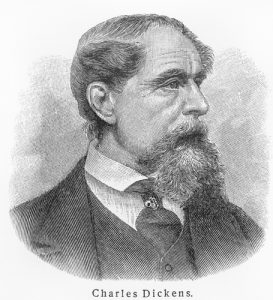
*Charles Dickens visited the town for research in 1838
- Around 1825, famed landscape artist JMW Turner, painted a river view perspective of Barnard Castle while on a tour of the ‘North’. The painting was simply named ‘Barnard Castle’.
- “Barney Castle” is a phrase used in the regional dialect to mean “a pathetic excuse”. The term is thought to be derived from the action of Sir George Bowes who was the keeper at Barnard Castle during the ‘Rising of North’ incident of 1569 (see above).
- Tony and Rory Underwood, who went to school in Barnard Castle, were the first brothers to play together for the England rugby union team since Harold and Arthur Wheatley did it in 1937.
- The word “curfew” comes from the Old French phrase “couvre feu”, which means “cover the fire”.
- In 1838, Charles Dickens visited Barnard Castle and the surrounding area to carry out research for his forthcoming book ‘Nicholas Nickleby’.
Barnard Castle in the Spotlight!
In May 2020, Barnard Castle was put into the national spotlight when it was found that Dominic Cummings, Chief Advisor to the British Prime Minister, had driven to the town during the lockdown period of the COVID-19 pandemic. The media alleged that he had broken the government’s strict lockdown rules and wanted answers as to why he had left his London home, more than 250 miles away. Mr. Cummings denied any wrongdoing and said that he simply had driven to Barnard Castle from his parents’ home in Durham to check his eyesight since he had to drive back to London the next day. While a few people suggested Dom’s explanation was obviously a case of ”Barney Castle” (see above), quite a lot of other individuals tended to use much stronger expletives on the subject.
Notable People
Some notable sportsmen who have an association with Barnard Castle, include;
- Rory Underwood, MBE, DL (19 Jun 1963) – is a former England international rugby union player who holds the team’s try-scoring record. He attended Barnard Castle School in the 1970s.
- Tony Underwood (17 Feb 1963) – is a former England international rugby union player and brother of Rory Underwood. He attended Barnard Castle School in the 1970s.
- Rob Andrew MBE (18 Feb 1963) – is a former England international rugby union player. A contemporary of the Underwood brothers, he attended Barnard Castle School in the 1970s.
Sport
Barnard Castle has two football teams:
Bowes FC
Bowes FC is an amateur football team that currently (2020) plays in the Crook and District Saturday afternoon league and plays its home games at Tens Field ground.
Barnard Castle Glaxo Rangers
Barnard Castle Glaxo Rangers is an amateur football team that currently (2020) plays in the Crook and District League 2nd Division.
Things to see and do!
Here a few recommendations of things to see and do in and around Barnard Castle:
- Barnard Castle – is a ruined remains of a 12th-century Grade I listed building that is situated on a rocky outcrop high above the River Tees. It’s in the care of English Heritage and opens to the general public 7 days a week. The opening time is 10 am – 6 pm in the summer with somewhat shorter hours during winter months.
- Bowes Museum – is a large mid-19th century building whose architecture is reminiscent of a French chateau. It’s a listed building and houses one of the best fine art/decorative art collections in the UK. There’s a programme of events and exhibitions throughout the year. Surrounded by parkland, woodlands and formal gardens, there’s also a children’s play area, a shop and a café.
- Egglestone Abbey – is a 13th-century ruin of a small monastery of the Premonstratensian Catholic religious order. It’s picturesquely situated close to the west bank of the River Tees.
- Witham Hall – better known as ‘The Witham’ is a restored mid-19th century building in the town centre that houses a theatre, cinema, music hall, gallery, café and gift shop. It also hosts regular events, fairs and markets.
- Teesdale Alpacas – is located about 4 miles south of Barnard Castle. It’s a working Alpaca Farm that runs Alpaca Treks and Farm Visits throughout the year. Both can be tailored to suit individual requirements.
- Wetheriggs Animal Rescue Centre – is a small family-run animal sanctuary located at Thorpe Farm, about 8 miles from Barnard Castle. It currently houses over 600 animals. It’s open every day and has a small admission charge.
- Rokeby Hall – (aka Rokeby Park) dating from 1730 is a grand country house about 3 miles from Barnard Castle. It’s been described as one of the ‘purest’ examples of neo-Palladian architecture. Group pre-booked tours are available on weekday afternoons.
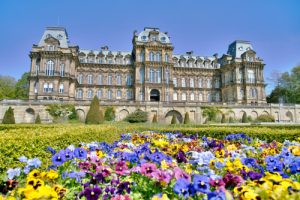
The imposing mid-19th century Bowes Museum building was built in a French Chateau style
Attractions Nearby
- High Force – is a waterfall with a single drop of 70 ft (21 m), making it one of the highest in England. Around 15 miles from Barnard Castle, there’s a car park at the entrance point as well as a gift shop and a small visitor centre. You can reach the waterfall, via a gentle woodland walk.
- Hamsterley Forest – is around 12 miles from Barnard Castle and covers more than 2000 hectares. It has a network of mountain- bike trails, walking routes and bridleways, as well as children’s adventure play area. There’s a café by the main car park entrance.
- Raby Castle – is a medieval castle located near Staindrop and 6 miles from Barnard Castle. It’s set in 200 acres of deer park. It was built by John Neville, 3rd Baron Neville de Raby and completed in about 1390. The castle is open at Easter, then May – September each year, 10 am – 4 pm daily.
Where to stay?
Accommodation in and around Barnard Castle is fairly limited and very much of a rustic B & B/Guesthouse/Inn style. Broadly speaking, expect to pay around £60 – £100 for 2 adults sharing per night. There’s obviously more choice a little further afield where more luxurious accommodation generally falls between £100 – £200.
Thinking of moving?
Are you thinking of moving to Barnard Castle? The average price of a property in Barnard Castle stood at £210,200 in September 2020, reflecting a fall of 4.6% in the last 12 months. In terms of the different property types in the town, the average asking price of a flat is currently £136,700, a terraced house £168,200 and semi-detached house £182,200.
So there we have it our quick guide to Barnard Castle one of the fine historic market towns in the region. If you fancy exploring the region have a look at our other County Durham guides.
Photo credit t0 *Nicku/Shutterstock.com
Why not give our Barnard Castle quiz a go?
Quiz Maker – powered by Riddle
